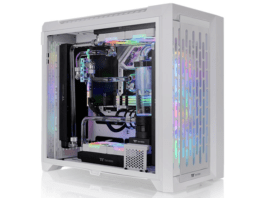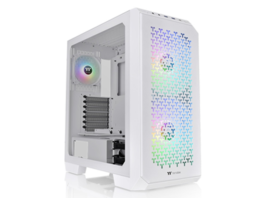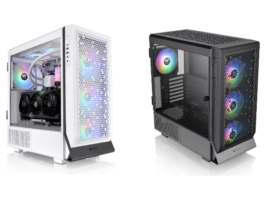Brand: Fractal Design
Model: Arc Midi R2
RRP: £70 (At time of review)
Fractal Design is a company with a short but rich experience with their solid and well-designed chassis. While Fractal may not be known for their innovation when it comes to products they are definitely well known for their focus and priority when it comes to overall build quality and aesthetics.
With me today I have Fractal’s top end mid tower chassis; the Arc Midi R2, with a focus on offering high airflow and maximum compatibility. The out of the box support for many water cooling options including a dual radiator in both the front and top ensures Fractal are definitely catering to their market by offering this, especially, with more and more closed loop water cooling coolers are hitting the market.
Specifications
ATX, Micro ATX, Mini ITX motherboard compatibility
2 – 5.25″ bays
8 – 3.5″ HDD trays – all compatible with SSDs
2 – 2.5″ additional SSD positions behind the motherboard plate
7 + 1 expansion slots
7 – Fan positions (3 Silent Series R2 fans included)
Filtered fan slots in front, top and bottom
CPU coolers up to 180 mm tall
PSU compatibility: ATX PSUs up to 170 mm deep when using the bottom fan location; when not using this fan location longer PSUs (up to 270 mm deep) can be used
Graphics card compatibility: Graphics cards up to 290mm in length with the top HDD cage installed – With the top cage removed, graphics cards up to 430mm in length may be installed
26 mm of space for cable routing behind the motherboard plate
Thick rubber grommets on all holes on the motherboard plate
Colours available: Black
Case dimensions (WxHxD): 230 x 460 x 515mm
Net weight: 10.7kg
Package dimensions (WxHxD): 320 x 610 x 560mm
Package weight: 12kg
Looking at the box it definitely has quite a low key sort of design due to the generic brown box and the lack of colour in general. However, upon closer inspection there is definitely a little bit more to it than meets the eyes. On the one side there is a diagram of the full chassis showing what it looks like; although a simplistic approach I appreciate it nonetheless. On the opposite side there is a large exploded diagram of the chassis, this definitely appeals to how my mind works and is most definitely a bit more important than meets the eye because it allows you to quickly glance and see how the chassis actually works.

After looking at the outside of the box you’re confronted with large polystyrene inserts housing the chassis within, I definitely wouldn’t be worried about how well protected the chassis is. I can vouch for this as I received it direct from Fractal HQ in snowy old Sweden and it turned up 100% perfect with not a slight bit of damage to note.

After sliding the chassis out of the mammoth inserts I take a look at the front of the chassis which is a very simple affair being made primarily of plastic except for the mesh which is instead made of metal of some description. At the bottom of the front panel you can see the fractal logo, moving up there is the two drive bays which I feel in today’s market is plenty unless adding dual bay reservoirs to your water cooling setup.

Next is the top of the chassis which has a fair bit more going on than the front due to the fact that it houses the front (or top?) I/O panel. The I/O is a little bit sparse not offering all that much in regards to connectivity but what it does have it does quite well including:
1 x Headphone Port
1 x Microphone Port
2 x USB 3.0 Ports
1 x Power Switch
1 x Reset Switch
1 x Fan Controller (5v, 7v, 12v)
The inclusion of the fan controller is a rather nice touch as most of the time when included, the switches are put in the most awkward of places – fortunately Fractal has learned this lesson as it’s in a very easy access position allowing you to change fan speed on the fly effectively. As I mentioned before, I’m not entirely happy about the lack of ports but more than that I feel that 2 front USB ports is on a small side and that if it had 4 ports it’d be far more appealing. In addition to this, the fact that the power and reset button aren’t next to each other I find a little bit odd and it’s driving my attention to detail crazy. Overall the front I/O is good offering most of what normal users need. Alongside the I/O there is also a large mesh on the top which you can mount additional or different fans to.

Looking at the rear of the chassis it’s quite a simple affair offering the basics which is to say a fan, rear I/O, expansion slots, PSU mounting and more interestingly another expansion slot positioned away from the motherboard. This expansion slot can be used for a few things first and foremost being for additional USB ports or perhaps additional ports for your sound card. I quite like the idea of its addition with the only problem being the sacrifice of water cooling grommets to secure its placement, which for some, might be a little bit of a deal breaker. That being said I feel like it’s better for the majority of users as opposed to grommets which are definitely used by the minority.

Looking to the bottom of the chassis you’ll see there’s a fair bit more going on than you’d traditionally see in a chassis housing a fan mount and removable dust filter. This is something becoming increasingly more common on the higher end chassis and it’s something I’m surprised wasn’t implemented sooner. With this kind of configuration it’s possible to mount the power supply facing the bottom allowing it to have a cold air intake which means rather than using the power supply fan as a glorified exhaust fan you’re able to effectively separate it thermally from the rest of your system . Additionally the removable dust filter is a nice touch although it is becoming a requirement these days on a chassis placed within this pricing bracket.

Moving on to the side panels, not really much going on here besides the tinted window on the left side panel of the chassis. The window is quite nice offering a nice little insight to the chassis without showing much of the components I’d consider ugly such as the HDD bays etcetera.

Looking towards the motherboard tray it’s very clear that Fractal has given a fair bit of attention to detail in regards to the design, nothing ground breaking but these slight usability features make installing and cable routing in the chassis very easy compared to a chassis without these features. The first of note is the bars popped back which allow you to cable tie directly to the motherboard tray using whatever you can thread through be it string, a cable tie or even Velcro! Next up is the ability to install two 2.5” drives on the rear of the motherboard tray, this might not seem all important but when you consider it effectively adds two extra drive bays especially as SSDs have become very popular. Finally a more common occurrence is the rubber grommets to both hide and protect cables which run from behind the motherboard tray to the main chamber of the chassis.

The front drive bays are a similar story not being tool free and functioning pretty much as expected, I was a little bit disappointed to notice there was a lack of a 5.25” to 3.5” adapter was not included meaning for my personal setup I had to use a sape one I had lying around to add the extra USB ports I needed.

Moving on to the drive bays which feature their own version of mounting brackets which seem to change wildly between manufacturers. Fractal’s own take on this is pretty simplistic although typical of my experiences with Fractal certainly delivers on how solid the build quality feels. This particular bracket is not tool free, as it doesn’t even use thumbscrews to mount which is a bit of a shame. Next thing to note on the drive bays is that they’re modular meaning that if you only use two SSDs or similar you could remove all of them an instead mount a thick dual radiator in the front quite comfortably.

Installation inside this chassis was very much a pleasure. The tool-less fitting of the PCI brackets and HDD bays was a simple affair. The fact that you can remove the brackets entirely is also a welcome site as this allows you to fit a radiator in the front of the case, or just a longer graphics card if required. This may seem like a limiting factor but that is the price you pay when using a case that is not entirely designed to accommodate a water cooling system.

One good thing to mention is that Fractal haven’t made the mistake that some manufacturers do is that this chassis doesn’t shred you to pieces when installing and overall is quite a safe endeavour.
Aside from the few tool less niggles I didn’t have a hitch whilst installing. One notable area is the accessibility when it comes to cable management with ample room behind the motherboard tray to route even the beefy 24 pin cable with plenty of room to spare. In addition to this, the little inserts on the tray really helped with taming the mass of cables and is one of the closest designs to perfect I’ve yet to use. One negative point is I feel that the routing holes would have been significantly better if there were three holes without spacing as opposed to two with spacing as that would have meant that I could have slotted in my 24 pin directly rather than moving diagonally from the top hole.
To conclude, my experience with the Fractal Arc Midi R2 has been very positive. There are a few areas which I feel are little bit lacking like the build materials. I appreciate the price bracket of this chassis but if Fractal was to bring out something like this in a premium material such as aluminium then they would rocket further up on my favourite manufacturers list than they are now.
On a more relevant note to the Arc Midi R2, I definitely like Fractal’s no nonsense approach to tool free design. A large chunk of chassis manufacturers make claims of tool free design, but in reality, you find yourself with a screwdriver all the same. I appreciate the honesty, and I don’t feel like tool free design is anywhere near as important as some people seem to make it out to be.
Installation within the chassis was an absolute pleasure with the comprehensive cable management options which allowed me to get it to look exactly how I wanted it to, which is a rare trait nowadays when it comes to cable management. It would have been nice to see a few more thumbscrews used, but if critical to you, you’re always able to buy some ones to fit the chassis after buying it.
Aesthetically the chassis looks amazing. Fractal Design, as the name may suggest, are definitely one of the kings when it comes to making a chassis which both looks great and functions well. What’s better is their ability to pack in so much cooling performance under the hood of this beautiful chassis, admittedly it’s not surprising when you realize that half of the chassis is actually made of mesh and can have a fan screwed in place. For a chassis of this size the ability to mount 7 fans inside is crazy.
The acoustic performance isn’t the best I’ve heard but definitely isn’t the worst. At 5v the sound coming from the chassis is definitely manageable and certainly doesn’t penetrate even open back headphones. Bottom line is, good sound performance – not the best, the addition of some quieter fans.
As for actual build quality there is not a single issue, this thing is built like a tank. Although at the cost of being so heavy I almost want to call it the immovable object – not ideal if you’re a heavy LAN player.
To conclude, the chassis is a great all around performer, nothing is particularly ground-breaking in terms of performance but there is not a single weak aspect, there are chassis out there which have so much airflow it’s like a wind tunnel but usually at the cost of both noise and aesthetics. If you’re looking for ultimate thermal performance then this probably isn’t the chassis to be looking for – but if you just want a chassis which performs well, sounds good and looks great then this is a real winner.

-
Performance
-
Design
-
Value
Summary
The Fractal Arc Midi R2 combines style with substance and at a pretty tempting price of around £70 (At the time of review), it gives Fractal another highly competitive entry in what is an already a populated market.




